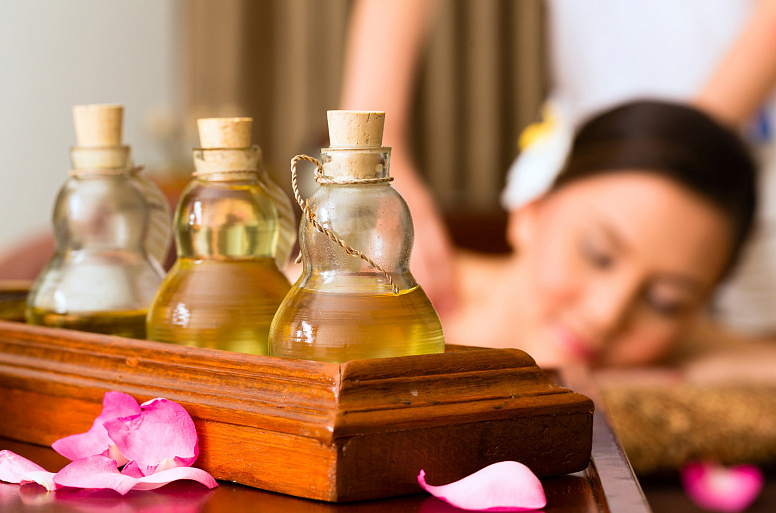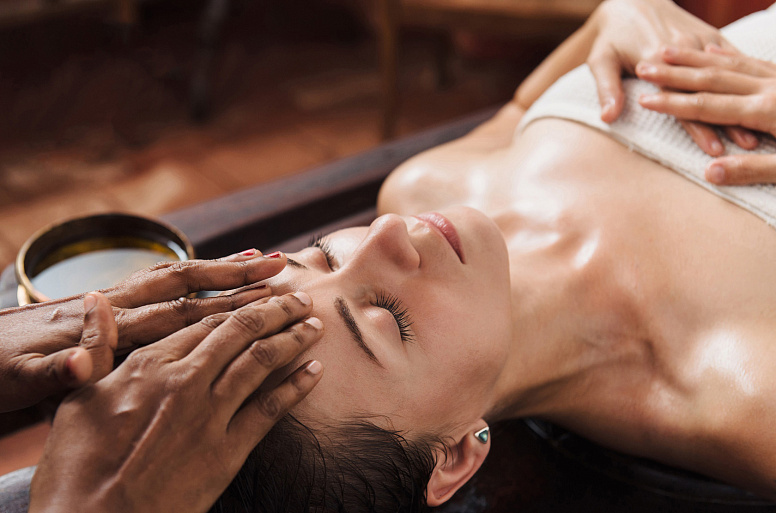“Just as a clay pot is strengthened after being smeared with oil, just as skin gains resilience through oiling, or as a wheel axle gains durability when lubricated, so the body gains smooth skin, calms Vata-dosha disbalances, and learns to withstand physical strain through the practice of Abhyanga” (Ashtanga Hridaya Samhita).
Anyone who has heard of Ayurveda, even briefly, knows that oils have a great significance in this ancient holistic practice. Their cosmetic and therapeutic uses, internal and external, their aid in prevention, treatment, and recovery from disease, and their role in panchakarma make them a vital component of this study. Oils are rubbed into the body, used for baths or oil enemas, dropped into sense organs, and consumed internally during meals. This article will elaborate on the benefits and contraindications of this daily oiling procedure, the steps in selecting appropriate oils, and the proper technique of oiling your body at home.
How to choose oil for a daily massage
In Ayurvedic texts, oiling of the body is called Abhyanga. Oiling is not exactly a massage, since the skin is only covered with oil, rather than being kneaded or felt; however, the comparison of this procedure to a full-body oil massage makes the concept more comprehensible to modern-day people.
When considering the types of massage oils and the rules for their selection, it’s important to note that there exists no universal oil that suits everybody; you should instead rely on three indicators to help determine which is most beneficial:
- Prakriti, or individual constitution;
- Vikriti, or current state or hardships;
- time of year.
Among these indicators, which relate to the dominance of a particular dosha and its exhibited qualities, elements like cold and heat play a major role.
Vata and Kapha are considered cold doshas and thus require warmed oil for massage; the hot dosha of Pitta, on the other hand, must use oil that is cooled.
Suitable oils for each dosha:
- Vata — sesame, mustard, castor oil;
- Pitta — sunflower, coconut oil;
- Kapha — sesame, mustard, corn oil.
Besides these basic oils exist pre-mixed combinations for body massage, designed and manufactured in India:
- Vata — Mahanarayan, Bala Ashwagandha, Ksheerabala;
- Pitta — Pinda, Triphala;
- Kapha — Dashamoola.
Accordingly, warming oils will be best during the cold season due to the prevalence of Vata and Pitta, while the warm season associated with Pitta requires oils that cool the body.
Besides that, it’s important to note that the head is related to Pitta (heat), so oiling of the head should be done with cooling oils such as Brahmi. For facial massage, Kumkumadi is one of the best oils, although original sources do not prescribe a single oil for the face and instead suggest that it varies according to season- for instance, sesame oil will work well in winter while coconut oil is better for summer massages.
Daily oil massage: benefits and contraindications
Just like most other procedures, oiling has both benefits and certain limitations or contraindications.
As stated in the Ashtanga Hridaya Samhita, “[Abhyanga] should be done daily, [in the] morning. It delays ageing, relieves tiredness and excess of Vata (aches and pains). It improves vision, nourishes body tissues, prolongs age, induces good sleep and improves skin tone and complexion.”
This sutra reveals a list of the beneficial properties of Ayurvedic oiling:
- The skin becomes glowing, clean, smooth, and elastic, develops a healthy tone, and is relieved of dryness or wrinkles.
- Many pains are relieved and the conditions of joints, tendons, and circulation are greatly improved.
- A human body treated through oiling does not deteriorate excessively when damaged or subjected to heavy work (lifting, carrying heavy weights) and instead becomes strong and flexible.
- The body is toned by the removal of toxins (ama), improved digestive power, delayed aging processes, and increased general wellbeing.
- Regular oiling at home helps develop crystal clear vision.
- Ayurveda states that oiling pacifies Vata-dosha, providing improved wellbeing, good sleep, developed body tissues, and strength of the physical body as well as the nervous system .
- Abhyanga clears the mind of vanity and depressive thoughts, accelerating the mind’s function and improving memory and attentiveness.
Although these positive effects appear attractive, oiling also has certain contraindications.
According to the Ashtanga Hridaya Samhita, “[m]assage should be avoided when there is an increase of Kapha in the body, soon after Shodhana (Panchakarma procedure) and during indigestion.”
Specific contraindications for Abhyanga:
- acute respiratory diseases, fever;
- menstruation;
- days of Panchakarma (cleansing procedures);
- diarrhea, indigestion, excess Kapha;
- acute skin conditions.
In the case of excess Kapha, oilless massages like Garshana and Udvartana should be used.
Proper oiling technique
Now let’s talk directly about the process of oiling. The technique of oiling the body is part of dinacharya, or ‘daily routine,’ so the frequency of the procedure plays a large role.
Regularity. As stated above, original Ayurvedic sources suggest that “[i]t should be done daily,” but commentaries on these texts clarify that Abhyanga should rather be done with intervals of 1-3 days, not constantly.
The procedure’s frequency is determined based on one’s constitution, current wellbeing, capabilities and lifestyle, as well as the time of year. The maximum frequency, or once a day, is acceptable for individuals with a predominance of Vata-dosha; people with excess Kapha should instead perform oiling once every three days.
Beginners should perform this procedure only 1-2 times a week and be patient, for it typically takes several weeks to see the first results.
Implementation time. The most favorable time for performing Abhyanga is considered to be early morning, since this procedure is best implemented on an empty bladder and stomach, when one has an existing feeling of hunger. This way, while the energy channels are pure, the oil easily enters through the skin pores and is absorbed by internal digestive fire. Oiling can be performed at other times as well but only under these conditions: at least 2-3 hours after eating and at least 3 hours before bedtime.
Location. It is important to ensure that the room for the procedure is warm; placing a blanket underneath your feet to avoid slipping and freezing is highly recommended.
Oils. We’ve already listed the suitable oils for Abhyanga, but either way,sesame oil is a versatile option for oiling that warms, nourishes, and softens the skin. It can be used during the cold season, but heating the oil in a water bath or similar container with hot water is always recommended, regardless of the selected oil type. If several oils are to be used for different parts of the body, make sure to prepare suitable containers for each.
Sequence and special areas. There is no strict order for applying oil to the body, but often people go from top to bottom. Start by oiling the scalp, ensuring that only the base of the hair is oiled, then continue downward along the classic massage lines to the ears, face, and, eventually, the feet.
Oil the abdomen, including the navel area, in a clockwise manner. Devote special attention to the head, ears, and feet during the massage; if your time for Abhyanga is limited, prioritize these three areas mentioned above. Keep all movements slow, smooth, soft, and circular to balance the qualities of Vata-dosha.
Warming, showering. The final step involves warming the body to facilitate rapid absorption of oil, which can be done through physical activity or a hot shower or bath. The oil may absorb immediately or require additional means to remove, such as ubtan, mung bean flour, or chickpea flour; in the latter case, add a little water to the substance, bring it to a puree consistency, apply it to the body and gently wash it off.
Take time to dry after Abhyanga, especially before going outdoors during the cold season.
Daily oiling has a unique effect on the body! We encourage you to use this instrument to maintain your health and wellbeing.


